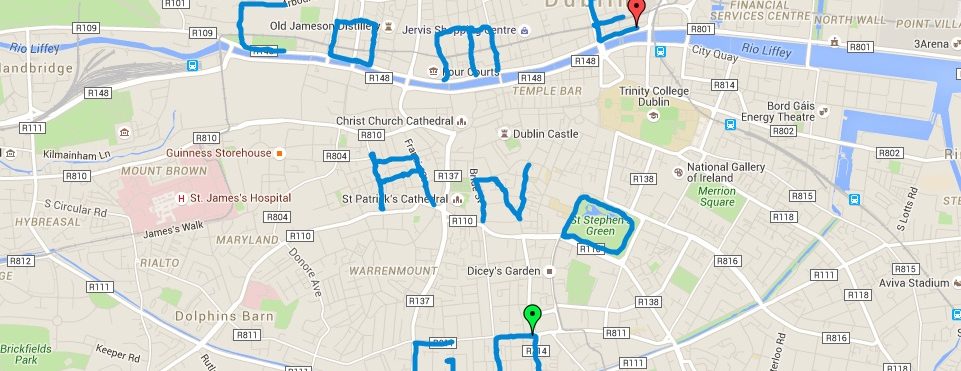Hybrid Territories
Post do Taming the spaces discute o que o autora, Kai Pata, chama de “hybrid ecology”, e que poderia colocar em meu termos como “hybrid informational territory”, mostrando a relação entre tecnologias locativas e o ambiente e a fusão da esfera eletrônica e o espaço físico. Parece que cada vez mais as formas de mapeamento e de localização, elevadas à potência com as tecnologias de informação, fazem com que o mapa seja mesmo o território (uma “realidade/virtualidade aumentada”), e o mapeamento, forma de territorialização. Talvez possamos dizer que estamos nos aproximando do mapa de Borges (Del Rigor de la Ciencia, 1960) que tinha, no conto, a escala 1×1, ou seja, o mapa é o território. Localizar e consumir informação (GPS, RFID, SMS, Bluetooth…) passa a ser uma forma de “movimento” pelo espaço, de produção e consumo do espaço, de produção de espacialidade, de lugar, notadamente o espaço urbano.
Trechos do post e um vídeo de “realidade aumentada” para telfones celulares, Ínvisibles”, apresentado no ArtMov Festival em Belo Horizonte, Brazil, e novembro de 2007:
“(…) The previous aspects of hybrid ecology are quite general and deal with the nature of individuals acting in an environment. What happens if the environment too becomes hybrid?
Recent trends in the Web development have caused the immersion of borders between the real and virtual spaces, giving rise into the new potential learning environment. New kind of social software eg. blogs, wikis, social bookmarking services, social artifact repositories enable user integration into democratic content-development and publishing. Mashup technologies allow publishers to syndicate their data into machine-readable RSS feeds to which readers can selectively subscribe with free social software. Geotagging systems make it possible to create locative content by mobile devices, situated both in real and virtual environment (Tuters & Varnelis, 2006). Locative content is digital media applied to real places, any kind of link to additional information set up in space together with the information that a specific place supplies, which is triggering real social interactions with a place and with technology (Tuters & Varnelis, 2006; Hanzl, 2007, Kaipainen & Pata, 2007).
This new learning environment – an augmented reality/virtuality – consists of distributed virtual spaces generated by social software tools, and of the real spaces and objects, in which locative content has been added with mobile devices. Augmented reality, the reality overlaid with virtual reality, and virtual reality, in which representations of the real world have been embedded and contextualised, is enabling interactions both in real and virtual spaces. Lonsing (2004) suggests that an augmented reality system generates a composite view in real time – a combination of a real scene viewed by a user and a virtual scene generated by a computer, where the real scene is submerged with additional information in order to enhance the perception of the user.
Rich layers of embodied knowledge and practice in the real spaces, and authentic context triggering activities and knowledge-building in virtual spaces, makes augmented space into a potential learning environment with new challenges for the learners. This new learning medium is a distributed activity space in which learners meet other learners, knowledge artifacts and practices.
New augmented learning environment provides novel tools and triggers new types of activity patterns in this distributed space. Possible learning patterns involve both actions in real and virtual spaces – thus we need to view this space as one whole.
Several community-activities with new technologies can be built upon the relationships between real spaces/objects, people and meanings:
Space with dynamically embedded meanings (eg. spoken narratives, movement) entails action potentials. The embodiment of these action potentials is a process of coupling affordances evoked by internal imagination and goals in one hand, and the perceived and culturally predefined external affordances from the environment, on the other hand. As a result, this space becomes into a place for new interpretors and starts triggering activities.
Question is of course when can persons in such places perceive the patterns of activities, when can they perceive affordances of the certain culture to interact with this culture? (eg. How much geotagged content at places/virtual content in blogs, social repositories there needs to be, that it would reveal activity potentials for triggering certain community activities. What happens if the activity potentials coupled with different anticipated activity potentials, how do such creative threads and activity derivations emerge and influence the augmented reality activity potentials?)
In which areas of the augmented reality (real or virtual) can the activity potentials be actualized, will the proceeding activity take place in the same dimensionality or can it cross the imaginary border of these spacial dimensions of the augmented reality?(eg. i can add geotagged content in real place, but later it starts my virtual activities in virtual space, that in turn can be traced as activity patterns from the real place)”
